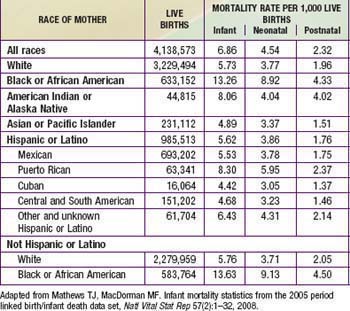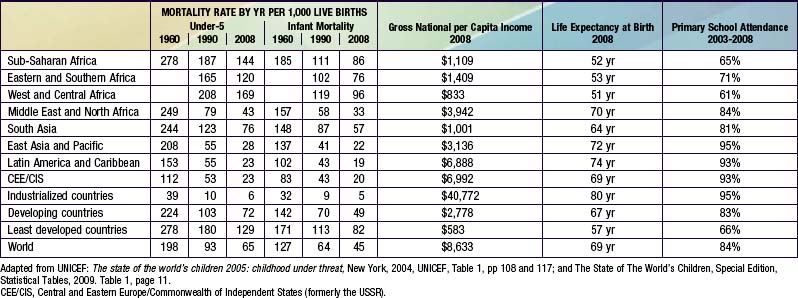Chapter 1 Overview of Pediatrics
Scope and History of Pediatrics and Vital Statistics
Reducing Child Mortality
Despite global interconnectedness, child health priorities continue to reflect local politics, resources, and needs. The state of health of any community must be defined by the incidence of illness and by data from studies that show the changes that occur with time and in response to programs of prevention, case finding, therapy, and surveillance. To ensure that the needs of children and adults across the globe were not obscured by local needs, in 2000 the international community established 8 Millennium Development Goals (MDGs) to be achieved by 2015 (www.countdown2015mnch.org). Although all 8 MDGs impact child well-being, MDG 4 (“Reduce by two-thirds, between 1990 and 2015, the under-five mortality rate”) is exclusively focused on children. Globally, there has been a 23% reduction in under-5 mortality since 1990 (from 93 to 72 deaths per 1,000 live births), with a 40% reduction in developed countries (10 to 6) but only a 21% reduction in the least developed countries (180 to 142). In 62 countries progress was inadequate to meet the goals and 27 countries (including most of those in sub-Saharan Africa) made no progress or declined between 1990 and 2006. There were nearly 13 million under-5 deaths in 1990; 2006 marked the 1st year that there were fewer than 10 million deaths (9.7 million) with a further decrease to 9.0 million in 2007 and 8.8 million in 2008. However, overall progress has not been on target to reach the goal (Fig. 1-1).
Across the globe, there are significant variations in infant mortality rates by nation, by region, by economic status, and by level of industrial development, the categorizations employed by the World Bank and the United Nations (Table 1-1). Most of the decline in infant mortality in the USA and other industrialized countries since 1970 is attributable to a decrease in the birthweight-specific infant mortality rate related to neonatal intensive care, not to the prevention of low-birthweight births (Chapter 87). The majority of deaths of infants younger than 1 yr of age occur in the 1st 28 days of life, most of these in the 1st 7 days; moreover, a large proportion of the deaths in the 1st 7 days occur on the 1st day. An increasing number of severely ill infants born at very low birthweight survive the neonatal period, however, and die later in infancy of neonatal disease, its sequelae, or its complications (Tables 1-2 through 1-4).
Table 1-2 DEATH RATES FOR ALL CAUSES, BY SEX, RACE, AND AGE: UNITED STATES, SELECTED YEARS 1960 AND 2005

Table 1-3 DEATHS RATES FOR ALL CAUSES AMONG CHILDREN AND YOUNG ADULTS ACCORDING TO SEX, RACE, HISPANIC ORIGIN, AND AGE: 2006

Table 1-4 INFANT, NEONATAL, AND POSTNATAL DEATHS AND MORTALITY RATES BY SPECIFIED RACE OR ORIGIN OF MOTHER: USA, 2005

Causes of death vary by developmental status of the nation. In the USA, the 3 leading causes of death among infants were congenital anomalies, disorders related to gestation and low birthweight, and sudden infant death (Table 1-5). By contrast, in developing countries, the majority of infant deaths result from infectious diseases; even in the neonatal period, 24% of deaths are caused by severe infections and 7% by tetanus. In developing countries, 29% of neonatal deaths are due to birth asphyxia and 24% due to complications of prematurity.
Health Among Postinfancy Children
Increasing attention has also been given to behavioral and social aspects of child health, ranging from re-examination of child-rearing practices to creation of major programs aimed at prevention and management of abuse and neglect of infants and children. Developmental psychologists, child psychiatrists, neuroscientists, sociologists, anthropologists, ethnologists, and others have brought us new insights into human potential, including new views of the importance of the environmental circumstances during pregnancy, surrounding birth, and in the early years of child rearing. The later 20th century witnessed the beginning of nearly universal acceptance by pediatric professional societies of attention to normal development, child rearing, and psychosocial disorders across the continents. In the last decade, irrespective of level of industrialization, nations have developed programs addressing not only causes of mortality and physical morbidity (such as infectious diseases and protein-calorie malnutrition), but also factors leading to decreased cognition and thwarted psychosocial development, including punitive child-rearing practices, child labor, undernutrition, war, and poor schooling. Obesity is recognized as a major health risk not only in industrialized nations, but increasingly in transitional countries. Progress at the turn of the 21st century in unraveling the human genome offers for the 1st time the realization that significant genetic screening, individualized pharmacotherapy, and genetic manipulation will be a part of routine pediatric treatment and prevention practices in the future. The prevention implications of the genome project give rise to the possibility of reducing costs for the care of illness but also increase concerns about privacy issues (Chapter 3).
Enormous disparities exist in childhood mortality rates across the globe (see Table 1-1). Among the ∼8.7 million childhood deaths occurring worldwide, ≈50% occur in sub-Saharan Africa, home to <10% of the world’s population. Fifty percent of the world’s childhood deaths are occurring in 6 nations; 90% of childhood deaths are occurring in only 42 of the world’s 192 nations. In 2008, the USA had an under-5 mortality rate of 8/1,000 live births. Forty-two nations had under-5 mortality rates lower than that of the USA, with Singapore, Finland, Luxembourg, Iceland, and Sweden having the lowest rates at 3/1,000. The comparable child mortality rate in sub-Saharan Africa was 144/1,000 live births. As of 2008, Afghanistan has the highest under-5 mortality rate of 257/1,000 live births, followed by Angola at 220/1,000 live births and Chad at 209/1,000 live births. In 1990 Afghanistan and Angola had an under-5 mortality rate of 260/1,000 live births, showing minimal improvement over 2 decades. Causes of under-5 mortality differ markedly between developed and developing nations. In developing countries, 66% of all deaths resulted from infectious and parasitic diseases. Among the 42 countries having 90% of childhood deaths, diarrheal disease accounted for 22% of deaths, pneumonia 21%, malaria 9%, AIDS 3%, and measles 1%. Neonatal causes contributed to 33%. The contribution for AIDS varies greatly by country, being responsible for a substantial proportion of deaths in some countries and negligible amounts in others. Likewise, there is substantial co-occurrence of infections; a child may die with HIV, malaria, measles, and pneumonia. Infectious diseases are still responsible for much of the mortality in developing countries. In the USA, pneumonia (and influenza) accounted for only 2% of under-5 deaths, with only negligible contributions from diarrhea and malaria. Unintentional injury is the most common cause of death among U.S. children ages 1-5 yr, accounting for about 33% of deaths, followed by congenital anomalies (11%), malignant neoplasms (8%), and homicides (7%). Other causes accounted for <5% of total mortality within this age group (see Table 1-5). Although unintentional injuries in developing countries are proportionately less important causes of mortality than in developed countries, their absolute rates and their contributions to morbidity are substantially greater.
Morbidities Among Children
In the USA, ≈70% of all pediatric hospital bed days are for chronic illnesses; 80% of pediatric health expenditures are for 20% of children. In 2006, about 13.9% of U.S. children were reported to have special health care needs; 21.8 percent of households with children had ≥1 child with a special health care need (Chapter 39). Significantly more poor children and minority children have special health care needs. Although there are multiple chronic conditions and the prevalence of these disorders vary by population, 2 of these morbidities—obesity and asthma—have a substantial and increasing presence worldwide and are associated with substantial health consequences and costs. In the USA, ∼25% of children and adolescents are overweight, representing a 2.3- to 3.3-fold increase over the past 25 yr. Similar rates have been reported from Australia and multiple countries in Europe, Egypt, Chile, Peru, and Mexico (Chapter 44).
Also increasing in prevalence among industrialized nations and in middle- and low-income nations with substantial urbanization are rates of asthma. In the mid-1990s, the USA reported an annual prevalence rate of wheezing of 57.8/1,000 among children ages 0-4 yr and 74.4/1,000 among youth ages 5-15 yr, approximately 2-fold higher than comparable prevalence rates in 1980. In 2007, the Centers for Disease Control and Prevention (CDC) estimated that 9% of U.S. children have asthma, including 19.2% of Puerto Rican and 12.7% of non-Hispanic black children. The International Study of Asthma and Allergies in Childhood has conducted a systematic review of asthma prevalence, with compelling evidence for a substantial global burden of childhood asthma, although rates vary substantially between and within countries. The highest annual prevalence rates are in the United Kingdom, Australia, New Zealand, and Ireland, with the lowest rates in Eastern European countries, Indonesia, China, Taiwan, India, and Ethiopia (Chapter 138).
Chronic cognitive morbidities represent another substantial problem. Although different diagnostic criteria have been applied, attention-deficit/hyperactivity disorder (ADHD) has been identified in 5-12% of children in countries across the globe. Rates exceeding 10% have been reported in the USA, New Zealand, Australia, Spain, Italy, Colombia, and Great Britain. Variations in cultural tolerance and/or differences in screening approaches or tools may account for some of the differences in prevalence of the disorder by country, but genetic and gene-environmental interactions may also play a role. Despite variations in rate, the condition is universal. Beyond the personal and familial stress caused by the disorder, costs to the educational system are considerable. It is estimated that in 2010 the U.S. drug treatment costs for ADHD will exceed $4 billion. In developing countries without resources for special education, these children are unlikely to fulfill their academic potential (Chapter 30).
Mental retardation affects ≈1-3% of children in the USA, with ∼80% of these children having mild retardation. Rates are severalfold higher among very low birthweight infants, although data from European cerebral palsy (CP) registries has revealed a significant decrease in the prevalence of CP in very low birthweight infants, from 60.6 per 1,000 live births in 1980 to 39.5 per 1,000 live births in 1996. In the USA, there is substantial variation in rates of mild retardation by socioeconomic status (9-fold higher in the lowest compared to the highest socioeconomic stratum) but relatively equivalent rates of severe retardation. A similar income-related distribution is found in other countries, including some of the most impoverished countries such as Bangladesh. Lower overall rates have been reported in some countries, including countries ranging from Saudi Arabia to Sweden to China; the difference is primarily in the prevalence of mild retardation (Chapter 33).
Special Risk Populations
Children in Poverty
Similar poverty-linked disparities may exist in countries with very high infant mortality rates (sub-Saharan Africa). In the low-income developing countries, the rate of infant mortality among the poorest quintile of the population is more than twice that of the wealthiest quintile (Fig. 1-2).










